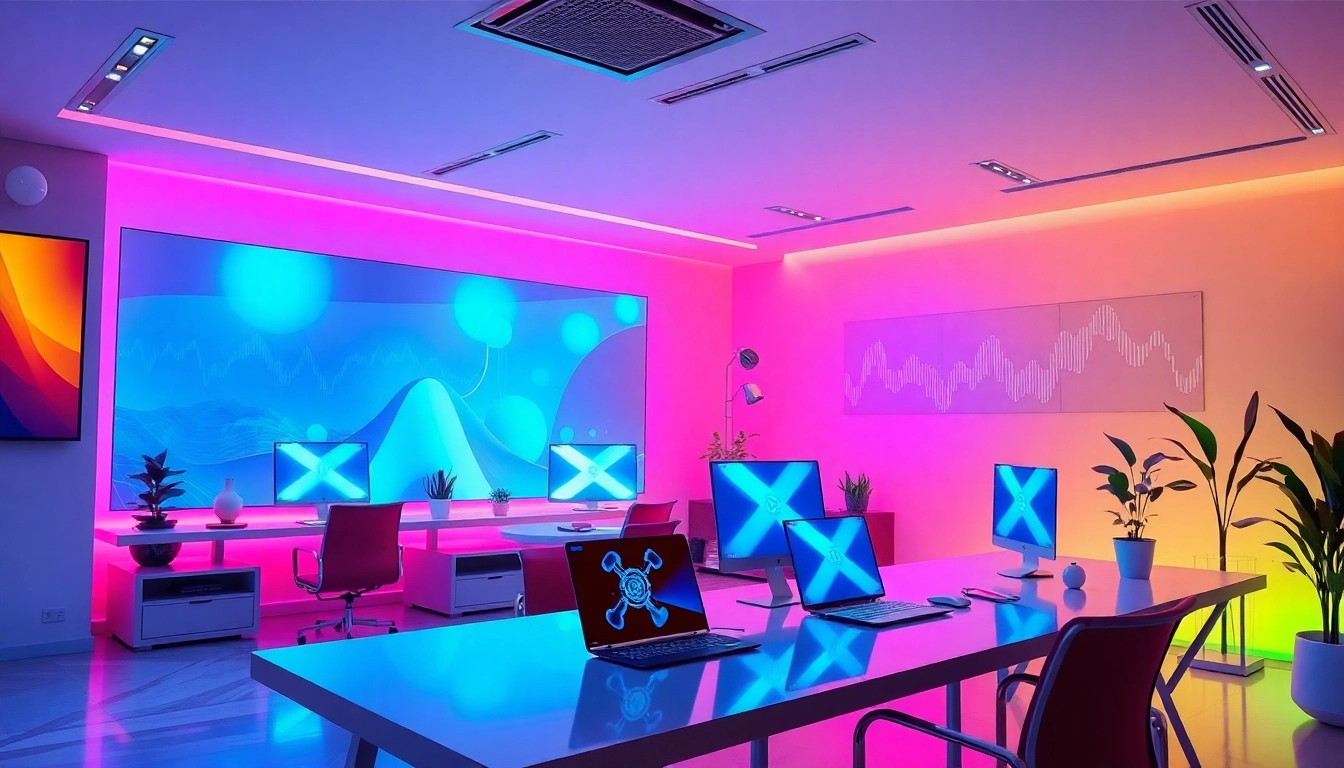Understanding the Importance of Web Design Missouri
In today’s digital landscape, the significance of web design cannot be overstated. As businesses in Missouri strive to establish their online presence, effective web design plays a crucial role in enhancing user experience and driving engagement. Quality web design is not merely about aesthetic appeal; it encompasses functionality, accessibility, and the ability to meet user needs efficiently. A properly designed website is an investment that can yield numerous benefits, positioning businesses for success in an increasingly competitive market. To explore how web design impacts business outcomes in Missouri, discover more about web design missouri.
Why Quality Web Design Matters
Quality web design serves as the foundation for a successful online identity. It reflects a brand’s professionalism and credibility, which can significantly influence a visitor’s first impression. If a website is visually appealing and easy to navigate, users are more likely to stay longer and interact with the content. Conversely, a poorly designed site may cause frustration, resulting in high bounce rates and lost potential customers.
A great design fosters trust. Research shows that users often judge a business’s credibility based on its website’s design. In Missouri, where local businesses compete intensely for attention, standing out with quality design can be the distinguishing factor that attracts and retains customers.
Key Elements of Effective Web Design Missouri
Effective web design combines various essential elements that work in synergy to create an optimal user experience. These include:
- Aesthetic appeal: The visual design should align with the brand identity and resonate with the target audience.
- Responsive design: Websites need to function seamlessly across various devices, including desktops, tablets, and smartphones.
- Usability: Navigation should be straightforward, enabling users to find information quickly.
- Content organization: Well-structured content that is easy to read attracts user attention and enhances engagement.
- Load speed: A website that loads quickly reduces frustration and keeps visitors on the site longer.
Impact on Business Outcomes
The impact of web design on business outcomes extends far beyond aesthetics. Here are several ways effective design contributes directly to business success:
- Enhanced conversion rates: Websites designed with user-centric principles tend to convert visitors into customers, leading to increased sales and revenue.
- Improved search engine rankings: Search engines favor well-structured, user-friendly websites, leading to higher visibility and organic traffic.
- Brand loyalty: A consistent and appealing design reinforces brand recognition, encouraging repeat visits and fostering loyalty.
Best Practices for Web Design Missouri
Responsive Design Techniques
With the rise of mobile browsing, responsive web design has become a critical component of effective web design in Missouri. This approach ensures that websites adapt to the screen size and orientation of the user’s device, providing a consistent experience across platforms. Key techniques for implementing responsive design include:
- Fluid grids: Layouts that use proportion-based sizing rather than fixed sizes allow for flexibility across different screens.
- Media queries: These CSS techniques enable different styles to be applied based on the device characteristics, enhancing user experience.
- Flexible images: Images should scale within their containing elements, ensuring they do not overflow on smaller screens.
Utilizing Modern Aesthetics
Modern aesthetics play a vital role in user engagement. Employing contemporary design trends can significantly improve the visual appeal of a website. Some popular trends include:
- Minimalism: A clean, uncluttered layout highlights essential elements and improves usability.
- Bold typography: Unique fonts can enhance readability and add personality to the website.
- Dynamic color schemes: Using color psychology can evoke emotions and guide user actions.
Improving Navigation and Usability
Clear and intuitive navigation is a cornerstone of effective web design. Users must easily find information without frustration. To improve navigation and usability:
- Implement a logical hierarchy: Organize content and establish a clear path for users to follow.
- Use descriptive labels: Menus and buttons should clearly indicate their function to promote user confidence.
- Include a search feature: Providing a search bar enables users to directly access specific content.
Tools and Technologies in Web Design Missouri
Essential Design Software
Several design tools facilitate the creation of visually appealing and functional websites. Essential design software includes:
- Adobe XD: A vector-based design tool beneficial for prototyping and collaboration.
- Figma: A web-based design platform allowing real-time collaboration among teams.
- Sketch: A design software for macOS users, perfect for web and mobile UI design.
Emerging Technologies to Consider
The web design field constantly evolves, introducing new technologies worth considering, such as:
- Artificial Intelligence: AI can optimize user experiences through personalization and predictive analytics.
- Voice User Interface (VUI): As voice search continues to grow, integrating voice search capabilities can enhance accessibility.
- Augmented Reality (AR): AR can provide interactive experiences, particularly for eCommerce sites, engaging users more effectively.
Integrating SEO with Web Design Missouri
SEO and web design must work hand-in-hand to maximize online visibility. Effective integration involves:
- Site speed optimization: Reducing load times positively impacts rankings and user experience.
- Mobile optimization: Mobile-friendly designs are essential for SEO as search engines prioritize mobile compatibility.
- Structured data: Implementing schema markup can help search engines understand the content and improve SERP visibility.
Measuring Success in Web Design Missouri
Defining Key Performance Indicators
To assess the effectiveness of web design, it’s crucial to define Key Performance Indicators (KPIs). These may include:
- Traffic metrics: Monitor overall site visits, unique visitors, and referral sources to analyze traffic trends.
- Conversion rates: Evaluate how many visitors complete desired actions, such as purchases or inquiries.
- Bounce rates: Track the percentage of visitors who leave the site after viewing only one page to indicate engagement levels.
Using Analytics for Improvement
Utilizing tools like Google Analytics provides deep insights into user behavior, enabling continuous improvement. Key features to analyze include:
- User flow: Examine how visitors navigate through the site to identify potential bottlenecks.
- Session duration: Measure how long users stay on the site to assess content effectiveness.
- Geographic data: Understanding where users come from can help tailor local content and marketing strategies.
Gathering User Feedback Effectively
User feedback is invaluable for refining web design. Implementing methods such as surveys, usability tests, and live chat can provide insights into user preferences and pain points. Key considerations include:
- Designing succinct surveys: Keep questions clear and focused to encourage higher response rates.
- Conducting usability tests: Observe real users interacting with the site to identify areas for improvement.
- Utilizing feedback forms: Provide users with an easy way to share their experiences and suggestions.
Future Trends in Web Design Missouri
Innovations Shaping the Industry
Staying ahead of trends is essential for anyone involved in web design. Here are some innovations currently shaping the industry:
- Dark mode: This feature enhances readability and can reduce eye strain for users.
- Microinteractions: Small animations enhance user interaction and add delight to experiences, keeping users engaged.
- Sustainability in design: Eco-friendly practices are increasingly valued, motivating designers to consider their environmental impact.
Understanding User Experience Evolution
The evolution of user experience (UX) continues to redefine web design standards. Current trends emphasize:
- Personalization: Tailoring content and experiences to individual users increases engagement.
- Accessibility: Designing with inclusivity in mind ensures that all users, regardless of ability, can navigate the site.
- Storytelling: Engaging narratives can connect emotionally with users, making the content more memorable.
Preparing for Upcoming Web Standards
As technology advances, web standards evolve. Preparing for the future involves:
- Staying informed: Keep up-to-date with industry news, trends, and emerging standards to stay competitive.
- Adopting progressive enhancement: Build websites that provide a basic experience for all users while enabling advanced features where feasible.
- Implementing security measures: As online threats grow, integrating robust security protocols is necessary to protect user data and maintain trust.



